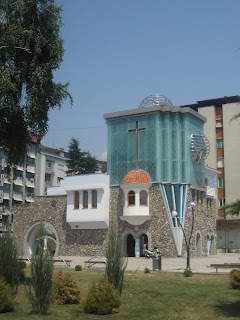

Skopje, the capital of Macedonia, is the least touristy city I have visited thus far. There was no tourist office, no tour groups and very few tourists. In fact, I felt like I was a tourist attraction for the locals, as more than half the people stared at me for being an Asian!
Due to massive destruction of the city during an earthquake in 1963, there were very few old buildings standing. Most of the architecture consisted of bland 1960s communist-era block buildings. Notable exceptions include the eclectic contemporary-designed Mother Theresa Museum, the Fortress Kale and various mosques and churches in the city. The Ottoman-era old bazaar is very similar to the ones in Sarajevo and Mostar, though more run-down. Most of the restoration work in the old town is being funded by international agencies and governments, including USAID.
One interesting observation is the wide use of the Cyrillic alphabet; in fact restaurant menus and street signs rarely use the Latin alphabet. Another intriguing sight is the use of EU flags on some buildings, even though Macedonia is not yet in the bloc.
The train journey from Skopje to Thessaloniki (Greece) was hellish! First, the train arrived 3 hours and 40 minutes late. It was so full that I was standing in the corridor. We also had to wait 80 minutes at the Greek border. All in all, what was supposed to be a 4-hour train ride took almost 9.5 hours! The only positive aspect about this experience was that I got to talk extensively to some locals about Macedonia.
Due to massive destruction of the city during an earthquake in 1963, there were very few old buildings standing. Most of the architecture consisted of bland 1960s communist-era block buildings. Notable exceptions include the eclectic contemporary-designed Mother Theresa Museum, the Fortress Kale and various mosques and churches in the city. The Ottoman-era old bazaar is very similar to the ones in Sarajevo and Mostar, though more run-down. Most of the restoration work in the old town is being funded by international agencies and governments, including USAID.
One interesting observation is the wide use of the Cyrillic alphabet; in fact restaurant menus and street signs rarely use the Latin alphabet. Another intriguing sight is the use of EU flags on some buildings, even though Macedonia is not yet in the bloc.
The train journey from Skopje to Thessaloniki (Greece) was hellish! First, the train arrived 3 hours and 40 minutes late. It was so full that I was standing in the corridor. We also had to wait 80 minutes at the Greek border. All in all, what was supposed to be a 4-hour train ride took almost 9.5 hours! The only positive aspect about this experience was that I got to talk extensively to some locals about Macedonia.




No comments:
Post a Comment